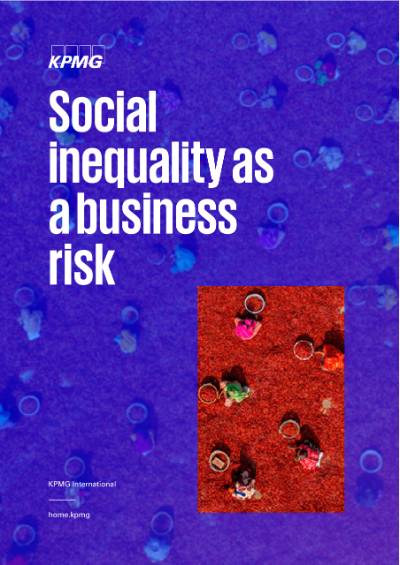COVID-19 has widened the equality gap, exacerbating deep, structural inequalities, setting back decades of social and economic progress. Society’s most vulnerable have suffered the most, with the World Bank naming 2021 ‘The inequality pandemic’1. Inequality between people is close to its highest point in 150 years, with the eight richest individuals holding the same wealth as the entire poorer half of the world – 3.6 billion people2. Poorer nations have also suffered disproportionately, as their governments lack the resources to provide extensive social safety nets.
And despite many governments reacting swiftly to COVID-19, overall trust in government continues to erode, leading in some cases to citizen activism. Only about half of people across OECD countries say they trust their national government3. A deteriorating economic environment, along with severe climate events, is fueling political and social unrest – creating a vicious circle of growing income inequality and deteriorating social cohesion.
Inequality is a business issue
For businesses, systemic inequality is a great source of risk. It limits productivity and has the potential to constrain consumer spending and growth, destabilize supply chains, trigger political instability, and jeopardize their social license to operate. At the same time, addressing inequity is a business opportunity.
But, with many businesses now dwarfing governments in economic scale, the private sector has a vital role to play in tackling inequality. In the quest for a peaceful and prosperous future, the United Nations Sustainable Development Goals (SDGs) call for cooperation between governments, civil society and the private sector.
Corporate leaders increasingly recognize how systemic social inequality negatively impacts the world around them, in addition to understanding how it can harm culture and productivity within the walls of their own businesses. Inequality puts companies at risk of legal, moral, and economic factors:
- The legal imperative
As businesses become bigger and more powerful, they have come under greater scrutiny, with rising expectations of environmental, social and governance (ESG) standards. We are seeing growing regulatory pressure to treat workers fairly, limit emissions and pollution, and positively impact people and the planet.
ESG reporting is becoming mainstream. Failure to provide evidence of ESG performance, and falling short of ESG targets and expected standards, can lead to penalties and, in some cases, personal lawsuits against senior executives. This in turn escalates reputational risk and may harm investment, sales and recruitment. - The moral imperative
Increasing stakeholder demands for corporations to ‘do the right thing,’ combined with the UN SDGs, ESG principles and other values frameworks helping them structure ‘how’ to do it, are leading businesses to prioritize ethical practices — and remain accountable for measurable progress.
Concepts like the ‘triple bottom line’ and ‘shared value’ suggest that social purpose and profit can be achieved together, such as through impact investing or by creating B-corps and social enterprises that achieve outcomes for people as well as profit. - The economic imperative
From a global perspective, there’s a symbiotic relationship between social equality and economic growth. The consequences of social inequality and an unstable business environment can limit the ability for companies to compete and grow, restrict the spending power of their target markets, and disrupt fragile supply chains.
Corporations that invest in improving social equity and examine their operations to reduce inequality make an important difference to the people in their organizations. But when companies work toward the same goals in tandem, they wield great power to effect positive change for many stakeholders over the long term.

Begin transformation to a purpose-driven organization
There is a strong case for becoming a purpose-driven organization. However, such a shift requires a fundamental transformation, with the following actions serving as starting points:
- Recognize social inequality as an opportunity for action as well as a business risk: ESG training as well as 1:1 work can help leaders recognize and understand the relationship between their organization and social inequality
- Build an inclusive culture: Within the organization, engage and listen. Align talent acquisition, training, development and promotion with principles of inclusion and equality. Data can improve transparency through measuring and monitoring how people with diverse backgrounds (including gender, race, sexual orientation, class, culture, and ability) thrive within the company.
- Assess social impact and measure it: Measure the social footprint of the organization — the impact of products and services and consumer wellbeing. Downstream, consider wellbeing in the supply chain. Often the first conversation is around what data is available and what needs to be collected to provide robust measurement on the social side.
- Give voice to the community and create a social compact: This can help businesses co-design solutions as well as report impacts within the community. With the right information and governance structures, businesses can put themselves in a position to take accountability and respond to community need.
Contact us
Connect with us
- Find office locations kpmg.findOfficeLocations
- kpmg.emailUs
- Social media @ KPMG kpmg.socialMedia
Related content
1World Business Council for Sustainable Development, “Vision 2050: Time to Transform” (March 2021) https://www.wbcsd.org/Overview/About-us/
2https://www.oxfam.org/en/press-releases/just-8-men-own-same-wealth-half-world
3https://www.oecd.org/gov/trust-in-government.html





